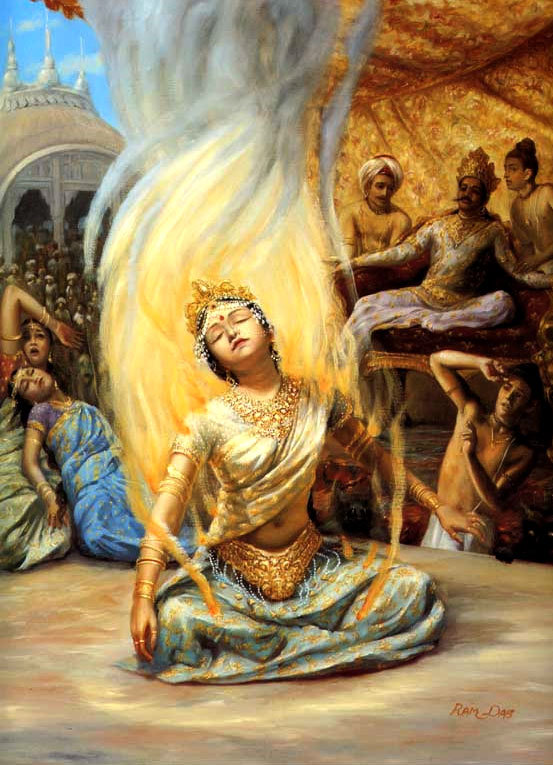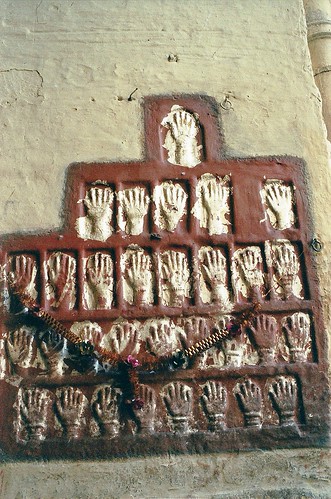The Rg-Vedic reference to Sati
The Rg-Veda contains a famous passage mentioning Sati – and preventing it. To a widow who is with her husband on his funeral pyre, the text says: rise up, abandon this dead man and re-join the living (10:18:8).
The Vedic testimony proves two things: (1) Sati already existed, and (2) it was disapproved of by the mainstream of the Hindu tradition.
Of course it already existed, going back at least to Proto-Indo-European days. It is also recorded among the Germanic and Celtic branches of Indo-European (in the Siegfried saga, his beloved Brunhilde follows the hero into death). As a general rule, it was more frequent in societies where women had honour to uphold, whereas societies where women were treated as household commodities (like the Greek) did not know the practice at all. Variations on Sati, with harem wives and servants following their kings into death, are recorded in ancient Egypt, ancient China, Mongolia (where the introduction of Tibetan Buddhism put an end to it) and other societies. So India was not that exceptional.
 The Mahabharata confirms the practice’s existence among the aristocracy, esp. with the self-immolation of Pandu’s beloved wife Madri (while his other wife Kunti does not consider it). She may have felt guilty, having seduced Pandu to have intercourse with her in spite of knowing that he was cursed to die from it; but she may also not have valued life without her husband. Greek sources of the last centuries BCE testify that the wives of Indian warriors killed in battle committed self-immolation.
The Mahabharata confirms the practice’s existence among the aristocracy, esp. with the self-immolation of Pandu’s beloved wife Madri (while his other wife Kunti does not consider it). She may have felt guilty, having seduced Pandu to have intercourse with her in spite of knowing that he was cursed to die from it; but she may also not have valued life without her husband. Greek sources of the last centuries BCE testify that the wives of Indian warriors killed in battle committed self-immolation.
One episode even describes how a dead soldier’s two widows quarrel over who will be the Sati.Mind you, they quarreled for the right to self-immolate, not to make the other one self-immolate, for it was voluntary and indeed required some will-power to overcome the family’s resistance.
It is not true that, as some internet Hindus claim, Sati dates to the Muslim or even to the British period. It may be true that in some cases, families forced widows to commit Sati under pressure from altered British inheritance laws, but under these new circumstances it was still Hindus themselves who misused a hoary Hindu practice. They even cited a skewed reading of the Rg-Vedic verse in support of Sati, a classic case of the pliability of “tradition”.
As for the Muslim period, typical for some battles was that Hindu warriors fought to the death and their wives who had remained in the towns committed collective self-immolation or Jauhar, not to fall into the hands of the Muslims. This was a specific practice building on the long-existing Hindu practice of Sati, but not to be confused with it.
It was confined to the real or would-be warrior castes, though, in keeping with their ethos of pride and passion. For Brahmins it was forbidden, a negative judgment going back to this Rg-Vedic verse. Taking such a momentous decision within at most 24 hours between the husband’s death and his cremation, under the impact of heavy emotions, was deemed to be in conflict with the Brahmin ethos of self-control. It is only logical that some rulers in the Brahmin-dominated Maratha confederacy forbid the practice even before the British East India Company Governor Lord William Bentinck (under prodding from Hindu reformer Ram Mohan Roy) abolished it by law in 1829. Brahmin and other high-caste widows were expected to remain loyal to their deceased husbands and refrain from remarrying, no matter how young they were. They became white-clad widows, often kept at a distance because of the stench of death figuratively hanging over them: primitive belief held them responsible for the death of their husbands (the converse implication of the belief that the wife’s force protected the husband). Though lower castes widely emulated this practice by the time European travelers recorded Hindu customs, the rule and often still the practice among low-castes had been that no womb should go unused and so widows remarried.
What is so puzzling about Sati for moderns in general and multiculturalists (in India: secularists) in particular, is that as per numerous testimonies, most self-immolating widows went into the pyre voluntarily, often overcoming pressure from their relatives or from the authorities not to do it. The shrill feminists who were protesting the Sati of Roop Kanwar in 1987 (calling it “murder”, a view which the Court refused to uphold) don’t want to understand this, but the testimonies are clear. The problem is that willing Satis confront the multiculturalists with a really different view of death, of freedom and of a woman’s place.
Multiculturalism may be fun as long as it’s about exotic cuisine or Buddha statues in the garden, but here it gets really serious: actual difference between our and their conception of the rights of woman. Here was a class of women who, even as brides, knew very well that their husband’s death would leave them with the option of self-immolation, and accepted the custom.
 Then again, we’ve been here before. In some Western countries, progressives have stood up for the right of women (effectively, of their parents) to commit female circumcision. All over the Western world, it is considered progressive to stand up for the right of Muslim women to cover their faces, even on passport photographs. Under their creed of cultural relativism, progressives ought to defend Sati as well, instead of being judgmental and applying narrow-minded Western prejudice to it. Alternatively, they might hold on to the modern “prejudice”, condemn Sati, and admit that multiculturalism has its limits.
Then again, we’ve been here before. In some Western countries, progressives have stood up for the right of women (effectively, of their parents) to commit female circumcision. All over the Western world, it is considered progressive to stand up for the right of Muslim women to cover their faces, even on passport photographs. Under their creed of cultural relativism, progressives ought to defend Sati as well, instead of being judgmental and applying narrow-minded Western prejudice to it. Alternatively, they might hold on to the modern “prejudice”, condemn Sati, and admit that multiculturalism has its limits.
Only a tiny minority of the Hindus, and even of the caste most famous for it, the Rajputs, ever committed Sati, but the practice had and largely still has a much wider constituency of supporters. Temples are erected for the women who committed it, where their heroism and loyalty is venerated: the Satisthal-s (now rebaptized as Shaktisthal-s, since Roop Kanwar’s Sati triggered a prohibition on the glorification of Sati). In South India, these women are commemorated with standing stones or Satikal-s, while men who have died while defending their villages get their Virakal-s, “hero stones”. So, whereas few women ever committed Sati, those who saw and venerated the heroism of it, were many.
But is it a “Hindu practice”? Firstly, the practice goes back to the time when the current belief in reincarnation wasn’t prevalent yet. Husband and wife were supposed to go to heaven together. Later people adapted their beliefs; when asked, they will declare that people who die together, will find each other back is their next lives.
Secondly, Hindu scripture largely frowns on it but accepts it for the warrior caste. A good but also difficult point in Hindu ethics is its relativity: depending on caste, age group and circumstances, the rules may differ. Caste autonomy is also recognized, and the decision of the caste Panchayat (council) effectively overruled anything written in the so-called law books. For instance, Brahmins wrote law books sternly condemning abortion, yet pre- and postnatal abortion was rife in some castes. The current problem of female feticide is based on this “Hindu” tradition, yet is clearly forbidden by the equally Hindu law books. So, Sati also had a place in the Hindu commonwealth even if it was forbidden for most people.
Thirdly, Hinduism is more than the Vedas. Linguistically, it can be shown that the modern Indo-Aryan languages have descended from different dialects existing side by side with Vedic Sanskrit, rather than from Vedic itself. Religiously, different traditions existed side by side, the Vedic tradition being the most prestigious (Arya) and accepted as normative, yet others were also allowed to exist. Thus, for the past so many centuries, Puja has coexisted with Vedic Yajna. As scholars say, the Little Traditions coexist with the Great Tradition. This way, while Sati was not really inside the Vedic tradition, it found a place under the large umbrella of Hinduism.
The well-known Somali-born ex-Muslim writer Ayaan Hirsi Ali, while campaigning for atheism as an alternative to Islam, accepts that Muslim women in large majority will go on believing in Allah and venerating Mohammed for a while, and therefore encourages a progressive interpretation of Islamic law, esp. regarding the treatment of women. But one problem she runs into, is the decentralization of Islam: no matter that a lone liberal Mufti (jurisconsult) issues an opinion giving a progressive reading of Islamic law, this innovation is not binding on other Muftis or on the masses. It is not like in the Catholic Church, where the Pope or the Council can take decisions which are binding on every Catholic. Reform may be slow, but at least it has teeth. By contrast, in decentralized religions, paradoxically it is very difficult to impose change. In particular, no matter how many Hindu authorities or commoners say that they don’t want Sati, if one caste upholds it, it will continue at least in that community.
Hindus, however, much in contrast with Muslims, can effect reform starting below, through a change in mentality. Even the law books, deemed a hotbed of unchanging orthodoxy, explicitly lay down that reform is permissible, esp. if effected by those familiar with the spirit of the law books, who judge that in new circumstances it is better served by a new concretization. Hindus have spontaneously adapted much better to modernity. With some prodding from the secular state, but mainly be an evolution in mentalities, Sati is becoming a quaint memory. The conviction that for a widow, there is life after the death of her husband, is becoming generalized even among the castes where self-immolation was customary.
































1 Comment